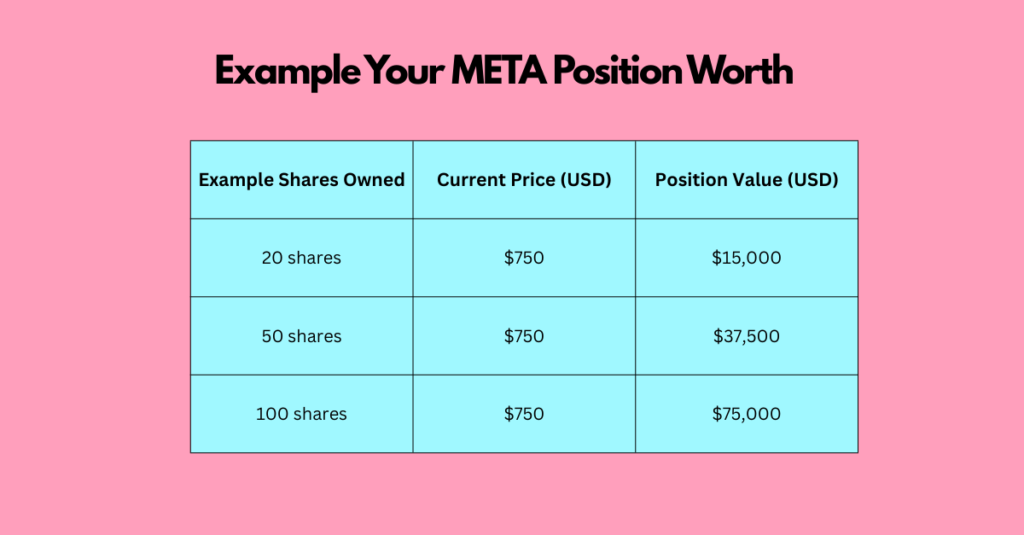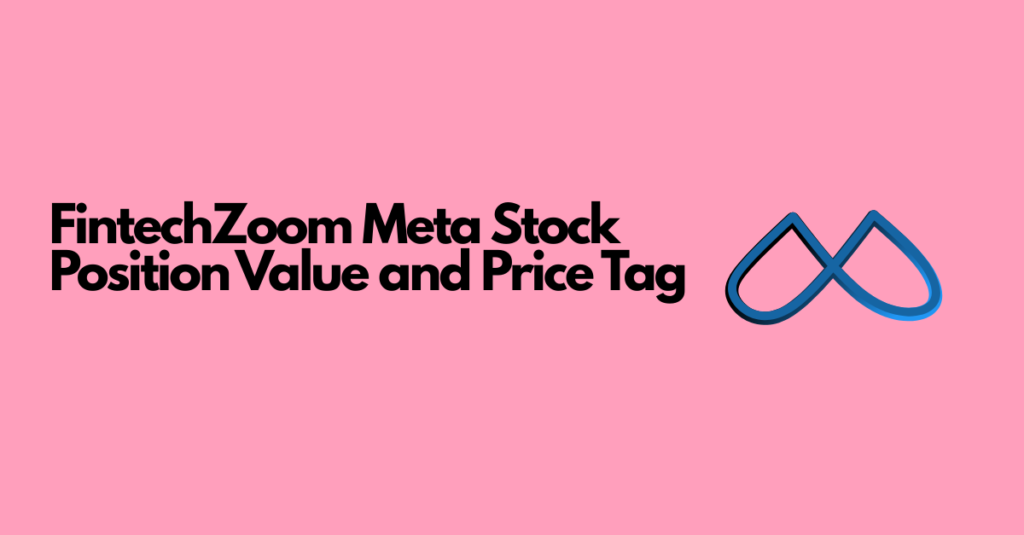Meta Platforms, the parent company of Facebook, Instagram, WhatsApp, and Reality Labs, remains one of the most closely watched names in global markets. Since its rebranding from Facebook to Meta, the company has transformed its business model, betting heavily on artificial intelligence (AI), digital advertising, and the metaverse. As a result, searches for fintechzoom meta stock have grown rapidly, with investors eager to understand whether the company’s current valuation and price tag justify future growth expectations.
- Current META Stock Price and Market Performance
- Calculating Your META Position Worth
- How Much Is My META Position Worth Today?
- META Stock Price Tag: What Does It Mean?
- META Market Cap and Valuation Metrics
- Analyst Price Targets for META Stock
- META Stock Price Target for 2025 and Beyond
- Calculating Returns: What If META Hits Target Price?
- META Price-to-Earnings Comparison with Peers
- Is META Still a Good Buy at Today’s Price Tag?
- Conclusion
- FAQs
In 2025, Meta stands as one of the most valuable companies in the world, with a market cap well above $1 trillion. Its stock continues to dominate trading volumes, making it a core holding in many institutional and retail portfolios. But with its share price swinging on earnings results, analyst forecasts, and regulatory pressures, understanding the true position value of Meta stock is crucial for investors.
This blog breaks down everything you need to know about Meta’s share price, valuation, analyst expectations, and how to calculate your personal position value. Along the way, we’ll also compare Meta’s valuation with peers, analyze its long-term prospects, and determine whether it deserves a place among the fintechzoom best stocks to buy now.
Current META Stock Price and Market Performance

Meta stock has remained resilient despite a volatile macroeconomic environment. As of September 2025, shares trade around the mid-$700 range, reflecting strong demand from investors betting on continued AI and advertising growth. This price tag is backed by impressive quarterly earnings that beat Wall Street expectations, driven by both ad revenue recovery and improved efficiency in the company’s operations.
Over the past year, Meta’s stock price has surged more than 40%, outperforming many of its peers in the tech sector. Market enthusiasm has been fueled by new AI-powered products, such as generative AI tools integrated into Facebook and Instagram, and early signs of monetization from the company’s metaverse investments.
Yet, volatility remains a key theme. Regulatory challenges in the EU and U.S., combined with competition from TikTok and Google, occasionally weigh on investor sentiment. Traders closely monitor price swings, as Meta often reacts strongly to earnings reports and product announcements.
Calculating Your META Position Worth

For investors, understanding the total value of your Meta stock holdings is essential. The position value represents the current worth of all the shares you own and is calculated by multiplying the number of shares by the current trading price. Knowing this helps you track gains or losses, manage risk, and maintain a balanced portfolio.
For example:
- If you own 50 shares of Meta at $750 each, your position value is $37,500.
- If the stock climbs to $900, that position increases to $45,000.
Investors can use brokerage apps, fintechzoom stock trackers, or portfolio dashboards to monitor position values in real-time. Adjustments for splits, buybacks, or dividends (if applicable) ensure accurate tracking over time.
Here’s a quick reference table:
| Example Shares Owned | Current Price (USD) | Position Value (USD) |
| 20 shares | $750 | $15,000 |
| 50 shares | $750 | $37,500 |
| 100 shares | $750 | $75,000 |
Using these calculations, you can easily see how changes in Meta’s stock price impact your portfolio. This also helps in deciding whether to add more shares, hold your position, or diversify into other tech stocks.
How Much Is My META Position Worth Today?

Retail investors often type variations of this question when checking the status of their portfolio. The answer depends entirely on the number of shares held and the latest trading price. Most brokers and financial portals provide live calculators that update instantly as the stock fluctuates.
For instance, someone who invested $10,000 in Meta five years ago would now see that amount grow substantially, given Meta’s strong returns since 2020. But the specific value always depends on real-time market prices.
Using fintechzoom meta stock trackers, investors can visualize not only their current position value but also historical performance, dividend adjustments (if any), and portfolio diversification statistics.
META Stock Price Tag: What Does It Mean?

When investors mention Meta’s “price tag,” they’re usually referring to its share price or overall market valuation. A stock’s price tag doesn’t always indicate whether it’s expensive or cheap; instead, valuation metrics like price-to-earnings (P/E) ratios and revenue multiples provide better context.
Currently, Meta trades at a premium compared to the broader market but at a discount relative to some high-growth peers. Its price tag reflects investor confidence in AI-driven ad revenue and future expansion into VR/AR technologies.
For long-term investors, the key is to evaluate whether the current price tag aligns with Meta’s expected growth. Buying during market pullbacks often offers better entry points, particularly when analyst consensus remains bullish.
META Market Cap and Valuation Metrics

Meta’s market capitalization currently exceeds $1.9 trillion, placing it among the most valuable companies in the world. Its P/E ratio, while elevated compared to traditional industries, remains reasonable when stacked against peers like Alphabet and Microsoft.
Key valuation metrics include:
- P/E ratio: Reflecting earnings strength relative to price.
- PEG ratio: Adjusted for growth expectations.
- Price-to-sales (P/S): Especially important in fast-growing tech sectors.
By these measures, Meta is not the cheapest stock, but it remains attractive given its strong cash flow generation and dominant position in digital advertising. Analysts often point out that Meta’s profitability is far stronger than many newer AI startups trading at similar valuations.
Analyst Price Targets for META Stock

Wall Street analysts continue to maintain bullish outlooks on Meta, though price targets vary widely. Recent reports show:
- Average target: $820–$880 per share.
- Bull case: Exceeding $1,000 if AI monetization accelerates.
- Bear case: Dropping toward $650 if regulatory risks or ad slowdowns materialize.
These targets reflect both optimism and caution. Bulls highlight Meta’s leadership in AI, while bears warn about its heavy investments in Reality Labs, which continues to post multi-billion-dollar operating losses.
Investors monitoring fintechzoom best stocks to buy now rankings will often find Meta consistently listed, thanks to its growth profile and dominant market position.
META Stock Price Target for 2025 and Beyond

Looking further out, analysts project Meta’s stock could trade well above $1,000 by 2027–2028, provided AI and metaverse initiatives scale successfully. The company’s push into generative AI services could unlock new revenue streams, while ad revenue remains a reliable cash engine.
However, long-term projections must account for risks:
- Regulatory pressure: Stricter rules on data usage.
- Competition: Google and TikTok remain strong rivals.
- Execution risks: Reality Labs has yet to deliver profits.
If Meta manages to balance its metaverse investments with AI monetization, long-term investors may see significant upside. Conversely, failure to deliver on these ambitious projects could weigh on future valuations.
Calculating Returns: What If META Hits Target Price?

For many investors, the most exciting part of owning Meta stock is projecting potential returns. Suppose an investor buys at $750:
- If the stock rises to $900, they earn a 20% gain.
- At $1,000, the return jumps to 33%.
- Long-term compounding, reinvested over multiple years, could produce substantial portfolio growth.
Meta does not currently pay dividends, meaning all returns are capital gains. Investors rely on price appreciation, making entry price and patience crucial. With tools from stock market fintechzoom and brokerage apps, calculating these returns is straightforward.
META Price-to-Earnings Comparison with Peers

When compared to other tech titans, Meta often looks attractively priced. Here’s a snapshot of P/E ratios and profitability margins for key peers:
| Company | P/E Ratio | Profitability Notes |
| Meta | Moderate | Strong ad revenue margins, scalable AI initiatives |
| Tesla | High | P/E elevated due to growth expectations, EV demand |
| Amazon | High | P/E inflated by reinvestment in business growth |
| Alphabet | Moderate-High | Strong profit margins, diverse revenue streams |
| Microsoft | Higher | Premium valuation due to cloud dominance |
This comparative analysis shows that while Meta isn’t the cheapest stock, it is still reasonable relative to earnings and growth. Many investors see it as a balanced option: not as speculative as smaller AI plays, but with more growth potential than mature giants like Apple.
Is META Still a Good Buy at Today’s Price Tag?

The ultimate question for investors is whether Meta’s current valuation justifies a buy. While the stock’s price tag is high, the underlying fundamentals remain strong. Advertising revenue is rebounding, AI products are scaling, and Reality Labs—while costly—could eventually pay off in the next decade.
For aggressive investors, Meta may be a growth cornerstone. For conservative investors, limiting exposure while diversifying across other tech names can reduce risk. As always, investment decisions should align with personal financial goals and risk tolerance.
Conclusion
Meta’s stock position value and price tag reflect both opportunity and caution. Its trillion-dollar market cap, strong earnings, and leadership in AI make it one of the most influential companies in the world. At the same time, high valuations, regulatory scrutiny, and heavy metaverse spending keep risks elevated.
For investors, the bullish case sees Meta continuing to dominate digital advertising, rolling out successful AI tools, and reaching new highs by 2028. The bearish case warns that regulatory setbacks, rising competition, and slowing ad growth could drag down margins, making today’s valuation harder to sustain.
Ultimately, whether Meta belongs in your portfolio depends on your investment style. Growth-focused investors may embrace the upside, while risk-averse ones might prefer smaller allocations. What’s clear is that Meta will remain a central player in conversations about the fintechzoom best stocks to buy now and a consistent headline in stock market fintechzoom analysis.
FAQs
Q: How do I calculate my Meta stock position value?
A: Multiply the number of shares you own by the current trading price. For example, 20 shares at $750 each equal a $15,000 position value.
Q: What is the current price tag of META stock?
A: As of September 2025, Meta trades in the mid-$700 range, with a market cap near $1.9 trillion.
Q: What are analyst price targets for Meta stock?
A: The average Wall Street target ranges between $820 and $880, with bullish projections above $1,000.
Q: Is Meta overvalued compared to peers?
A: Meta trades at a premium to the broader market but remains cheaper than some high-growth peers like Tesla. Compared to Alphabet and Microsoft, it’s relatively fairly valued.
Q: Can Meta still deliver strong returns for long-term investors?
A: Yes, if AI monetization and metaverse projects succeed, Meta could see its valuation climb substantially by 2028. However, risks remain, so diversification is key.




